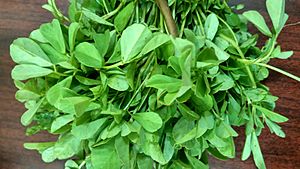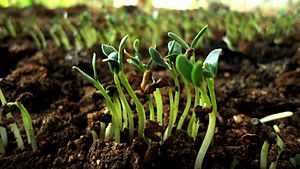Fenugreek production in India facts for kids
Fenugreek is a special plant grown every year. It's known for its strong smell and is used in many ways. People use its seeds as a spice and its leaves as a vegetable. It's also used in traditional Indian medicine, called Ayurveda, for things like skin care and hair health.
India is the world's biggest producer and exporter of fenugreek. Within India, the state of Rajasthan grows the most fenugreek.
Contents
What is Fenugreek Called?
The scientific name for fenugreek is Trigonella foenum-graecum. It belongs to the bean family, also known as Fabaceae.
In India, fenugreek has many different names:
- In Hindi, Oriya, Bengali, Punjabi, and Urdu, it's called methi.
- In Marathi, it's methya.
- In Kannada, it's menthya.
- In Tamil, it's vendayam or Venthayam.
- In Telugu, it's menthulu.
- In Malayalam, it's uluva.
- In Sanskrit, it's known as Medhika or Chandrika.
A Look Back: Fenugreek's History
People believe that fenugreek has been used in Indian cuisine for a very long time, possibly even 3,000 years ago! It grows naturally in places like Kashmir, Punjab, and the upper Gangetic plains in India.
Ancient Egyptians and Indians also used fenugreek. Later, it became known in Greece and Rome. In Egypt, people even burned fenugreek as incense during religious ceremonies to create "Holy Smoke." It was also used in the process of embalming.
Today, fenugreek is grown in many other countries, including Argentina, Egypt, and parts of the Mediterranean. People have always used its seeds as a spice and its leaves and young pods as vegetables. It was even fed to cattle!
What Does Fenugreek Look Like?
Fenugreek is an annual plant, meaning it grows and completes its life cycle in one year. It can grow up to about 60 centimeters (2 feet) tall.
- Leaves: The leaves are light green and have three small leaflets, each with slightly toothed edges.
- Flowers: It produces small, whitish flowers in April and May. These flowers usually grow alone or in pairs.
- Pods and Seeds: After the flowers, the plant forms bean-like pods. These pods are about 10 to 15 centimeters (4 to 6 inches) long. Each pod holds up to twenty small, yellowish-brown seeds that have grooves on them.
Fenugreek leaves are full of good things like carotene, vitamin A, ascorbic acid (Vitamin C), calcium, and iron. The seeds contain protein, starch, sugar, minerals, and vitamins. They smell a bit like curry but taste quite bitter. The seeds also have a special compound called diosgenin, which is used to make medicines.
India's Role in Fenugreek Production
India is the world's largest producer of fenugreek. In 2011–12, India grew over 121,000 tonnes of fenugreek seeds. Most of the fenugreek grown in India is also used within the country.
India also exports fenugreek to other countries. In 1960–61, India exported 799 tonnes. By 2011–12, this had grown to 21,800 tonnes! Fenugreek from India is sent to places like UAE, Sri Lanka, Japan, and European countries such as the UK, Netherlands, Germany, and France.
Within India, the state of Rajasthan produces the most fenugreek. Other states that grow a good amount include Gujarat, Madhya Pradesh, and Uttaranchal. In Rajasthan, farmers usually grow fenugreek during the winter. Tamil Nadu, Punjab, and Uttar Pradesh also grow fenugreek. There are many different types of fenugreek grown across the country.
How Fenugreek is Grown
Fenugreek plants prefer a moderately cool climate without frost, especially when they are flowering and forming seeds. They grow well in many types of soil that have a lot of organic material. The best soil is loamy or sandy loam, which drains water well and has a pH level between 6 and 7.
In North India, farmers usually plant fenugreek seeds from late October to early November. In South India, it's grown during both the Rabi (winter) and Kharif (monsoon) seasons. For Rabi, seeds are planted in the first half of October. For Kharif, they are planted in late June or early July. About 25 kilograms of seeds are used per hectare for planting. The plants usually produce more seeds during the Rabi season. On average, farmers get about 10–11 quintals of seeds per hectare. With better farming methods, this can increase to 15–20 quintals per hectare.
Before planting, fenugreek seeds are often treated with a special culture called Rhizobium. This helps the plant grow better. Seeds are usually planted in rows, about 30 centimeters (12 inches) apart, with 10 centimeters (4 inches) between each seed. They are planted less than 5 centimeters (2 inches) deep.
Farmers add compost or farmyard manure to the fields before planting to make the soil richer. They also add chemicals like nitrogen and phosphorus, depending on what the soil needs. After planting, the fields are watered right away, and then again at specific times as the plants grow. Good drainage is important to prevent too much water from sitting in the fields. Farmers also remove weeds and loosen the soil as needed.
Fenugreek is ready to harvest when the lower leaves start to fall off and the pods change color. Farmers cut the plants by hand using sickles. The harvested plants are tied into bundles and dried for 5–7 days. Then, the seeds are separated from the plants, either by hand or using machines. The seeds are cleaned and sorted, then stored in special bags in dry, airy places.
Uses of Fenugreek
Fenugreek seeds are used as a spice, and its leaves are used as a herb. Both are added to many dishes to give them flavor. The pods and leaves are also eaten as vegetables. Fenugreek leaves are especially good for you because they are rich in protein, minerals, and Vitamin C.
In North India and Punjab, fresh fenugreek leaves are a popular ingredient in many cooked dishes. When dried, fenugreek leaves are used like any other spice. The seeds can also be sprouted and eaten. Many people believe that fenugreek has various health benefits.



